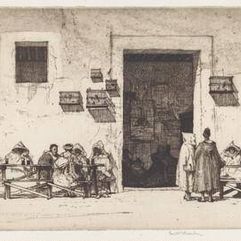
Louis Conrad Rosenberg
1890 - 1983
Louis Conrad Rosenberg was an American artist, architect, author, and educator active between 1914 and 1966 known for his precise staging and rendering of architectural scenes in Europe and the United States during the 1920s and 1930s.
Career
Louis Conrad Rosenberg made his living as an architect, educator, author, and fine artist. He transitioned freely among these different vocations over the course of his life as circumstances dictated, and enjoyed substantial success in all three. Though he began his career as a practicing architect, and returned to the professione several times, it was as a fine artist that he enjoyed his greatest recognition and reward. His 171 etching and drypoint estate prints, as well as scores of architectural illustrations and renderings in pencil, ink, watercolor and photographs have been archived at The University of Oregon in their Special Collections Division. He is considered, along with fellow M.I.T. graduates and World War I veterans John Taylor Arms and Samuel Vance Chamberlain, among America's greatest traditional architectural artists.
Rosenberg was recognized repeatedly with awards, prizes, exhibitions, and publications. His awards and prizes included the Silver Medal, California Printmaker's Society in 1924; The Logan Prize given by The Chicago Society of Etchers in the years 1925, 1927, and 1932; the Brooklyn Society of Etchers Prize in 1926, as well as Mrs. Henry F. Noyes Prize in 1932 and the John Taylor Arms Prize in 1938; and The Fine Arts Medal, The Architectural Institute of America in 1949. His alma mater, The Massachusetts Institute of Technology, established the Louis C. Rosenberg (1913) Traveling Fellowship in his honor, a highly sought-after prize that continues to be awarded today.
His work was exhibited by The American Academy, Rome in 1922; by The Royal Academy in London in 1925, 1926, and 1928; by The Royal Society of Painter-Etchers in 1927, 1928, 1932, and 1954; by The Chicago Society of Etchers in 1926, 1929, 1932, 1935, and 1939; by The Brooklyn Society of Etchers in 1928; by The Society of American Etchers in 1931, 1932, 1934, 1935, 1938, 1939, and 1940; by The National Arts Club in 1929; by The Cleveland Printmakers in 1931; by The Print Club of Philadelphia in 1932 and 1940; by The California Printmakers in 1934; by The Art Institute of Chicago in 1934 and 1938; by The Municipal Art Society, New York in 1934; by The National Academy in 1937; by The World's Fair, New York in 1939; and by The Massachusetts Institute of Technology in 1962.
His work was included in the annual editions of Fine Prints of the Year, published by Halston and Truscott Smith, London, in the years 1924, 1925, 1926, 1927, 1929, 1930, 1931, 1933, 1934, 1935, and 1936. He was the subject of Modern Masters of Etching, Number 22, L. C. Rosenberg, A.R.E. in 1922; of American Etchers, Volume X, Louis C. Rosenberg, The Crafton Collection, New York, 1930; as well as numerous articles and critical reviews in publications such as The Print Collector's Quarterly in 1928, American Artist in 1946, 1947, and 1957; Architecture Magazine in 1935, and various books published by The Architectural Book Publishing Company.
Life
With the start of World War II, Rosenberg enlisted in the U.S. Army and was assigned to a camouflage unit under the command of Aymar Embury, a New York architect. His company was sent to North Africa, where Rosenberg sketched and water-colored. These are included in the book Middle East War Projects of Johnson, Drake, and Piper, Inc., for the Army Corps of Engineers, 1942-43. The unit was broken up after eighteen months at which time Rosenberg returned to Portland, where he worked with local architects Glenn Stanton and Hollis Johnston for three years. He was living in Fairfield, Connecticut in 1946. He died in Oregon City, Oregon in 1983.
Text courtesy of Wikipedia, 2024






